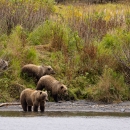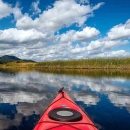States
AlaskaThe bald eagle is a common bird species on Kodiak Refuge. There is a long history of counting bald eagles on the refuge. This program began in the 1950s with boat surveys along the shores of Karluk Lake, and the first aerial survey was conducted covering all potential habitat on Kodiak Refuge in 1963. Beginning in 1982 a comprehensive census for nesting bald eagles was carried out every five years within the refuge boundaries. Results from these surveys indicated that the number of active eagle nests increased from 158 in 1963, peaked at 538 in 2002, and then declined to 398 in 2007. Including lands more recently added or now managed by the refuge on Afognak Island there were 439 active nests on the Refuge in 2007.
The increase in nests corresponds to similar patterns of growth in other Alaskan bald eagle populations in Prince William Sound, southeast, and interior Alaska. There are several possible factors contributing to the increase on Kodiak including elimination of the bounty on eagles in Alaska which set the stage for future population growth. Over 128,000 bald eagles were killed for bounty in Alaska between 1917 and 1952, although it’s unknown how many were taken on Kodiak. Other factors may include warmer climatic conditions and a shift in marine forage fish communities that occurred in the Gulf of Alaska in the early 1980s that may have provided increased food availability, and growth and range expansion of introduced black-tailed deer and mountain goats on Kodiak which provided carrion and increased over-winter survival.




